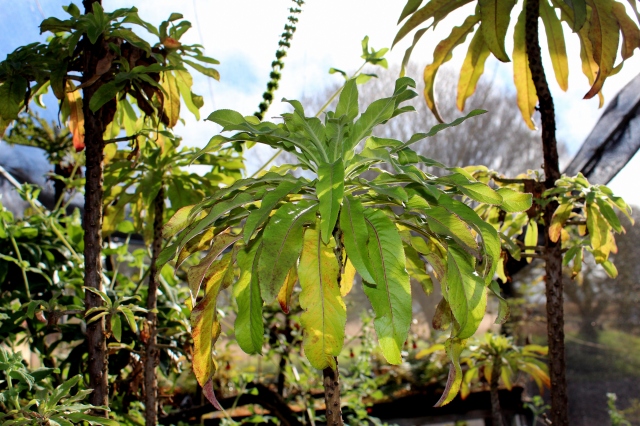Clermontia pyrularia
- Hawaiian Name: ‘Oha wai
- Conservation Status: Endangered
- Distribution: Hawai’i (Windward Mauna Kea; Leeward Mauna Loa)
- Date photographed: 8/24/2013
- Ease of viewing: Cultivation
- *Identification: Form– Terrestrial trees 3-4 m tall. Leaves– narrowly elliptic rarely oblanceolate; blades 15-28 cm long by 2.5-5 cm wide; margins callose-serrulate; winged petioles 1.5-3.5 cm long. Flower– calyx lobes triangular, 3-5 mm long; corolla white or greenish white, 40-45 mm long
- Phylogenetic comments: 2 papers have come out recently that show something interesting with the phylogeny of this species. Both Givinish, 2013 and Pender, 2013 have done DNA work on the Clermontia genus. In both papers, they surprisingly find that Clermontia pyrularia nests deeply with the genus Cyanea! It might mean that in the past there was some introgression with a Cyanea spp. or Clermontia as we know it is not monophyletic. 2022 update — The latest genetic work not only backs up that C. pyrularia is a solid member of the purple fruited Cyanea clade, but it or its ancestor was part of a hybridization event that lead to Cyanea leptostegia! I find it interesting because each species is found on opposite ends of the archipelago: C. pyrularia on Hawai’i island and C. leptostegia on Kaua’i.
- My notes: This was the species that I planted up at Hakalau. I thought it was a neat looking Clermontia; little did I realize what else lay in store.
- Links: Clermontia pyrularia SGCN (pdf); Smithsonian Flora of the Hawaiian Islands; Givnish TJ, Bean GJ, Ames M, Lyon SP, Sytsma KJ (2013) Phylogeny, Floral Evolution, and Inter-Island Dispersal in Hawaiian Clermontia (Campanulaceae) Based on ISSR Variation and Plastid Spacer Sequences. PLoS ONE 8(5): e62566. doi:10.1371/journal.pone.0062566; Pender, Richard “Flora trait evolution and pollination ecology in the Hawaiian lobeliad genus Clermontia (Campanulaceae)” Diss. U. of Hawaii, 2013, print
*From Manual of the Flowering Plants of Hawai’i

